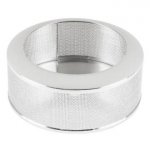^^
"CHAPTER 3
Preparative isolation of cannabinoids from Cannabis sativa by centrifugal partition chromatography
•••
Arno Hazekamp, Ruud Simons, Anja Peltenburg-Looman, Melvin Sengers, Rianne van Zweden, Robert Verpoorte
••
Leiden University, Department of Pharmacognosy, Gorlaeus Laboratories Leiden, The Netherlands
•
Published in J. Liq. Chrom. Rel. Technol. 2004, 27(15): 2421-2439
Abstract
A simple method is presented for the preparative isolation of seven major cannabinoids from Cannabis sativa plant material. Separation was performed by centrifugal partition chromatography, a technique that permits large scale preparative isolations. Using only two solvent systems, it was possible to obtain purified samples of the cannabinoids; (-)-∆9-(trans)- tetrahydrocannabinol (∆9-THC), cannabidiol (CBD), cannabinol (CBN), cannabigerol (CBG), (-)-∆9-(trans)-tetrahydrocannabinolic acid-A (THCA), cannabigerolic acid (CBGA) and cannabidiolic acid (CBDA). A drug-type and a fiber-type cannabis cultivar were used for the isolation. All isolates were shown to be 90-95% pure by gas chromatography. This method makes new cannabinoids available on a large scale for biological testing. The method described in this report can also be used to isolate additional cannabinoids from cannabis plant material."
https://openaccess.leidenuniv.nl/bitstream/handle/1887/12297/Thesis.pdf
"CHAPTER 3
Preparative isolation of cannabinoids from Cannabis sativa by centrifugal partition chromatography
•••
Arno Hazekamp, Ruud Simons, Anja Peltenburg-Looman, Melvin Sengers, Rianne van Zweden, Robert Verpoorte
••
Leiden University, Department of Pharmacognosy, Gorlaeus Laboratories Leiden, The Netherlands
•
Published in J. Liq. Chrom. Rel. Technol. 2004, 27(15): 2421-2439
Abstract
A simple method is presented for the preparative isolation of seven major cannabinoids from Cannabis sativa plant material. Separation was performed by centrifugal partition chromatography, a technique that permits large scale preparative isolations. Using only two solvent systems, it was possible to obtain purified samples of the cannabinoids; (-)-∆9-(trans)- tetrahydrocannabinol (∆9-THC), cannabidiol (CBD), cannabinol (CBN), cannabigerol (CBG), (-)-∆9-(trans)-tetrahydrocannabinolic acid-A (THCA), cannabigerolic acid (CBGA) and cannabidiolic acid (CBDA). A drug-type and a fiber-type cannabis cultivar were used for the isolation. All isolates were shown to be 90-95% pure by gas chromatography. This method makes new cannabinoids available on a large scale for biological testing. The method described in this report can also be used to isolate additional cannabinoids from cannabis plant material."
https://openaccess.leidenuniv.nl/bitstream/handle/1887/12297/Thesis.pdf
Last edited:




